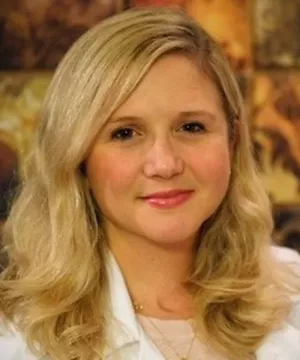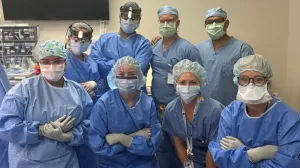Oncoplastic surgery treats breast cancer and helps women feel more like themselves

Tufts Medicine is the country’s leader in oncoplastic breast surgery, which combines the techniques of traditional breast cancer surgery with the reconstructive advantages of plastic surgery. The goal is to remove cancer while minimizing the unwanted effects of surgery, helping patients heal both physically and emotionally.
Tufts Medicine’s Sarah Persing, MD, MPH is a leading expert in breast surgical oncology, oncoplastic surgery, microsurgery and general plastic reconstructive surgeries at Tufts Medicine. She performs oncoplastic breast surgery at both Tufts Medical Center and MelroseWakefield Hospital.
Q. Can you briefly describe what oncoplastic surgery is?
A. Oncoplastic breast surgery involves combining the removal of the breast cancer using a plastic surgery design or techniques at the same time as removal of the breast cancer with lumpectomy by using the patient’s own tissue. These procedures may be performed only on the breast with cancer using local and regional tissue or on both breasts for symmetry.
An example of this would be a patient who has breast cancer with very large breasts and symptoms related to her large breasts. For this patient, a breast reduction design could be used to remove the breast cancer and also reduce the size of her breasts at the same time. A symmetry procedure for the other unaffected breast may also be performed at the time of surgery as well.
Q. How is oncoplastic surgery different from more traditional types of breast cancer surgery?
A. The traditional surgical management of breast cancer involves either breast conserving surgery (lumpectomy or partial mastectomy) or mastectomy (removal of the breast). Oncoplastic breast surgery is a type of breast conserving surgery that uses a plastic surgery design to perform the lumpectomy. Oncoplastic breast surgery helps to minimize the contour deformity of the breast following lumpectomy and can also improve the quality of life for patients.
Q: What is a Goldilocks mastectomy?
A: While the Goldilocks mastectomy is technically not considered “oncoplastic breast surgery” because it is a type of mastectomy, and not breast conserving surgery (i.e., lumpectomy), it is another example how combining a plastic surgery design in the approach to breast cancer surgery can optimize the outcome. In certain patients, a breast lift design may be used to perform the mastectomy. The remaining skin and fatty tissue may then be used to reconstruct the breast, or it may also be used for coverage over a breast implant. The breast lift design for the mastectomy enables a more aesthetic final reconstruction.
Q. Is everyone undergoing breast cancer surgery a candidate for oncoplastic surgery?
A. Patients who are candidates for breast conserving surgery may be candidates for oncoplastic breast surgery.
Q. What are some of the benefits of oncoplastic surgery?
A. Oncoplastic breast surgery has many benefits.
- Patients undergoing oncoplastic breast surgery will receive the standard of care for breast-conserving surgery for their breast cancer with the added benefit of improving the contour and symmetry of their breasts following the breast-conserving surgery.
- Oncoplastic surgery enables the surgeon to remove more breast tissue to reduce the chances of having to go back and do more surgery to remove the cancer.
- Oncoplastic surgery produces better outcomes in terms of cancer removal. Positive margin rates, or cancer not removed with oncoplastic breast surgery is 5-10% compared to 20-40% with standard lumpectomy.
- Oncoplastic surgery has also been shown to have higher patient satisfaction scores compared to standard lumpectomy and mastectomy with reconstruction. For patients with multiple cancers in the breast that would typically require a mastectomy, oncoplastic surgery may potentially be an option in certain situations for those patients in an effort to preserve their breasts.
- Oncoplastic surgery has been shown to be safe with similar recurrence rates and survival rates compared to standard lumpectomy and mastectomy.
We work with patients to understand what their goals are for breast reconstruction to find the procedure the best meets the primary objective of treating breast cancer in a way that helps them feel “normal.”
Q. Does the reconstructed breast look + feel similar to the pre-surgery breast?
A. Because we’re using the patient’s own breast tissue for reconstruction the look and feel of the breast is will be closer to that of the pre-reconstruction breast.
Q. Is the recovery from oncoplastic surgery longer/harder?
A. The typical recovery from surgery is 6 weeks before the patient can resume exercising and all other activities, but patients usually feel mostly back to normal after approximately 2 weeks. The surgery typically takes an additional 1 to 3 hours longer than a standard lumpectomy, but this depends on the type of reconstruction performed.


